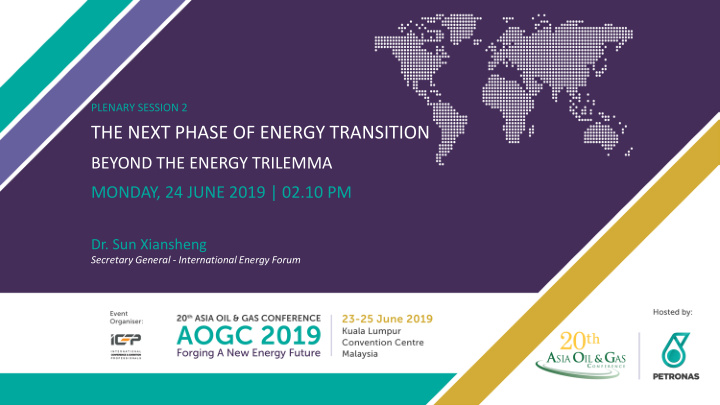



PLENARY SESSION 2 THE NEXT PHASE OF ENERGY TRANSITION BEYOND THE ENERGY TRILEMMA MONDAY, 24 JUNE 2019 | 02.10 PM Dr. Sun Xiansheng Secretary General - International Energy Forum
The Energy Goals - for any country Security • For the country, and international relations • For economic growth and stability • Affordability • For all consumers • By market forces and governments • Sustainability • For humanity (population reaches 9.7 billion in 2050) • For prosperity and growth within planetary limits •
I s it really a trilemma? –country perceptions Perceptions on Security vs Affordability vs Sustainability • Perceptions and priorities change based on • Status of the nation – Developed / developing • Affordability for the people – Rich vs poor • Resourceful – Having energy resources or import dependent • Technological capabilities – Innovation and access • Environment consciousness – Exposure to climate change impacts • Security impacts affordability (via price volatility and supply disruptions) • While sustainability indirectly dictates affordability (internalizing • externalities of climate change and pollution in prices)
How do emerging countries see this? Most of the Asian countries are emerging economies and majorly • dependent on imports Energy prices drive economic growth and prosperity • The present trend indicates • A balancing act between security and affordability • While paying secondary attention to sustainability • The future trend indicates • Sharper focus on sustainability • Air pollution, changing weather patterns / natural calamities • Impact on agriculture, livelihoods, and well-being • Direct & Indirect cost will affect both security and affordability •
How do advanced countries see these trends? OECD European and Asian importers: EU, Japan, Korea, Chinese Taipei • and North American and Asian exporters: US, Canada, Mexico, Australia Mostly saturated in terms of energy infrastructure and demand growth • Primary focus on • Fighting climate change • Increased thrust towards renewables and EVs • Amenable affordability to try and embrace clean energies • Changing import dependencies (EU) and export markets (US) •
But the future of oil demand growth is in emerging economies KBbl/d Crude Oil Imports 250000 200000 150000 100000 50000 0 2012 2013 2014 2015 2016 2017 2018 (Dec projected) Japan Korea China Chinese Taipei India China and I ndia will continue to grow oil imports while Korea and Japan plateau Source: JODI Oil
And so is the future of gas demand growth 300000 LNG Imports 250000 Mm3 LNG Imports 200000 150000 100000 50000 0 2012 2013 2014 2015 2016 2017 2018 (Dec projected) Japan Korea China Chinese Taipei India China LNG imports surge for more sustainability and will make it the largest gas importer overtaking Japan and Korea Source: JODI Gas
Factors beyond the trilemma Accessibility • Taking energy to the masses – Infrastructure (central & distributed) • Investments and enabling environment • Path, pace, and direction of transitions differ • Priorities changes for different countries • Investment and policy environment decides the pace of transition • Current energy sources • Renewables • Efficiency improvement • Digitization • Energy technology preferences– Gas / Oil / Renewables / Efficiency • Coal is ever less desired but remains a relevant reality •
Way Forward Identify synergies between requirements & policies of countries Bridge differences and build trust among producers and consumers Enhance transparency in energy markets for stability Overcome hurdles to integrate and transfer new technologies Accelerate efficiency gains through knowledge sharing
Recommend
More recommend